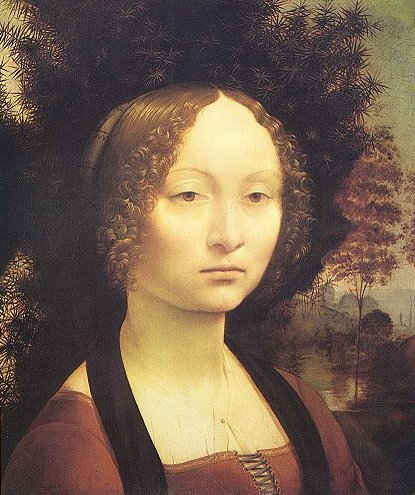|
This oil on wood painting is one of Da Vinci's very early works, and is usually dated as c. 1474, a time during which Leonardo was still with Andrea Verrocchio, and had been for about eight years. It was long debated as to whether Leonardo was behind this work; acceptance came with the realisation that during the period of 1470-1480 there were no other painters capable of such an impressive painting.
The lady is normally accepted to be Ginevra de' Benci, one of the most gifted intellectuals of her time. Historians generally consider the portrait was commissioned to celebrate the occasion of her marriage on January 15th, 1474 to Luigi Niccolini. She was seventeen; he was twice her age. Marriage portraits were a common practice at the time and most Florentine portraits of women were painted for just this reason. A number of things support this theory. On the reverse of the portrait is a heraldic motif consisting of a sprig of juniper encircled by a wreath of laurel and palm, along with the motto "Beauty adorns Virtue". The juniper plants are a symbol of chastity, highly appropriate for a marriage portrait, as well as being a pun -- in Italian -- on her name (the Italian name for juniper being ginevra). As with all of Leonardo's portraits there are disagreements over this one and some researchers feel it may have been commissioned by Bernardo Bembo, the Venetian Ambassador to Florence from 1474--76, and again in 1478--80. Bembo and Ginevra, both married, were known to have had a platonic affair, quite an accepted convention.
Unlike Leonardo's other portraits of women, this lady looks sulky, unforgiving and haughty; this is emphasised by the slightly smaller cast of one eye, making her look withdrawn. Her left eye seems to gaze directly at us while the right looks beyond to some invisible point. Like other Florentine women of the period Ginevra has shaved off her eyebrows (this is also obvious in the Mona Lisa). Maybe her expression indicates she was not entirely happy regarding her forthcoming marriage. In later life she was to go into self-inflicted exile in an attempt to recover from a severe illness; she was also tormented by an ill-fated love affair. The marble appearance of her complexion -- smoothed with Leonardo's own hand -- is framed by the undulating ringlets of her hair. This then contrasts beautifully with the halo of spikes from the juniper bush. Leonardo veiled the background of this portrait in a thin veil of mist known as sfumato (literal translation: "turned to vapour"); this being created with overlaid oil glazes. Though Leonardo did not create this effect he become well-known for his skillful use of it. At some point this canvas has had as much as on one-third cut from the bottom (estimates put the amount removed at around nine centimetres). This area would have been large enough to show her hands, folded or crossed, and resting in her lap. Their loss is a great shame as no one painted hands as beautifully as Leonardo. Luckily for art fans the loss may not be complete. The silverpoint drawing, to be found in the Royal Library at Windsor, could well be a sketch done in preparation for the Ginevra portrait. Mentally placing these fingers on the painting shows us that the fingers of her right hand would have been touching the laces of her bodice. This area of the portrait has been repainted and in normal circumstances an x-ray might well reveal the missing fingers -- if that same area had not been damaged and a new piece added. As a side note, this same hand sketch is thought to have inspired Escher's very famous hand drawing. Mutilation and repairs aside, this portrait is the best preserved of Leonardo's early works. This was the only privately-owned painting by Leonardo. In 1967 it became the first one of his paintings to join an American museum when the National Gallery in Washington bought it for a record five million dollars. |
|


